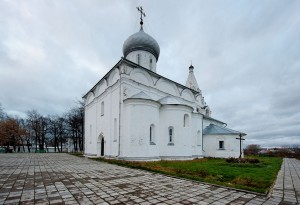Holy Trinity-Danilov Monastery, Pereslavl-Zalessky

The white-walled Holy Trinity Danilov Monastery is located in the southern part of Pereslavl-Zalessky. Twenty years ago he was in a very neglected state. After the revolution, the monastic buildings were given as apartments. The rich and powerful monastery was plundered and destroyed. Residents destroyed the iconostasis, destroyed the temples, dismantled the stone fence into bricks. From the ancient monastery fence there were only powerful Holy Gates and fragments with turrets.
The partial restoration was taken at the end of the fifties, but the real revival of the monastery began only in 1995. Over the past fifteen years, the Trinity Cathedral, the Church of All Saints, and the monastery wall have been fully restored. Now is the restoration of the refectory chamber and the Church of the Praise of the Mother of God under way.
Holy Trinity Danilov Monastery is active, services are held every day. Pilgrims come to worship the relics of Reverend Daniel Pereyaslavsky, but usually there are few visitors. The territory is neat, clean, despite the restoration work in full swing. The monastery is located on a hill with a beautiful view of the city - photographers will certainly appreciate.
The architectural ensemble sets the tone for the majestic single-domed Trinity Cathedral, the most ancient of the churches of the monastery. Its tent bell tower, decorated with elegant carved arches, largely forms the architectural appearance of the city. The Church of All Saints, once a hospital, is much more modest. Small and cozy, it is very good in the summer, among the blossoming grass. The refectory and the Church of the Praise of the Mother of God are massive structures with complex architecture and intricate wall decoration. Restorers will have to work on them a lot more.
HISTORY
The monastery was named after its founder, Reverend Daniel Pereyaslavsky. In addition to the usual monastic duties, he took care of the unknown dead - homeless, killed by robbers or frozen on the road. At night, he demolished the bodies of the dead in the urban poor woman (the burial place of wanderers and beggars) and prayed for the repose of their souls. In 1508, Daniel built a wooden All Saints Church at the burial site, around which the monastery began to settle. On the advice of the Grand Duke of Moscow Vasily III, he became the abbot of the monastery. At this time, Daniel turned 66 years old.
Basil III treated Daniel with special love and respect. The Grand Duke was childless for a long time. The long-awaited heir to Ivan (in the future - the Terrible) was presented to him by his second wife, Elena Glinskaya. According to legend, Vasily III summoned Daniel to Moscow and asked him to become the receiver of the newborn at baptism. And the Grand Duke made a generous donation to the monastic treasury for the construction of the stone Trinity Cathedral. After the death of Daniel of Pereyaslavsky, the main monastic relics were his relics, which rest in the Holy Trinity Cathedral and the Tikhvin Icon of the Mother of God, which belonged to the saint.
For the construction of the Trinity Cathedral began in 1530. In 1662–1668 Kostroma artists painted the church under the guidance of Guriy Nikitin and Sila Savina, famous painters of the 17th century.
In the Time of Troubles, the monastery was burned and looted by the Poles and Lithuanians. The monastery began to rebuild in the XVII century - at the expense of the boyar Ivan Baryatinsky, who took the veil under the name of Ephraim. Restoration work was carried out mainly by Kostroma architects. In 1683 they built a new stone church of All Saints instead of the former wooden one. Almost simultaneously with it, they built a bell tower. The Church of the Praise of the Mother of God with a refectory was built in 1695, and two years later the Holy Gates with a gate church and a stone fence were built.
From 1667 to 1669, the rector of the monastery was Gregory Neronov. Once a former associate of Avvakum and one of the ideologues of the church schism, he returned to the Orthodox Church (and, by the way, he did it twice). The abbot at the Holy Trinity Danilov Monastery sent him as a test, which he endured with honor - his management was exemplary. Gregory was buried in the porch of the Trinity Cathedral. At the beginning of the 18th century, the monastery was ruled by Varlaam Vysotsky, the confessor of Tsarevna Natalia Alekseevna, the sisters of Peter I. Subsequently, he converted Martha Skavronskaya (Catherine I) to Orthodoxy and also became her confessor. Under him, the relics of Daniel Pereyaslavsky were transferred to the Danilovsky side-altar of the Trinity Cathedral and placed in a silver crayfish.
From 1753 to 1788, Pereslavl Theological Seminary worked on the territory of the monastery, and then the Theological School.
Join our tours and take a look at this amazing attraction:
Excursions - www.uvisitrussia.com/day-tours/tours-to-golden-ring/
Tours - www.uvisitrussia.com/tours-to-golden-ring/



